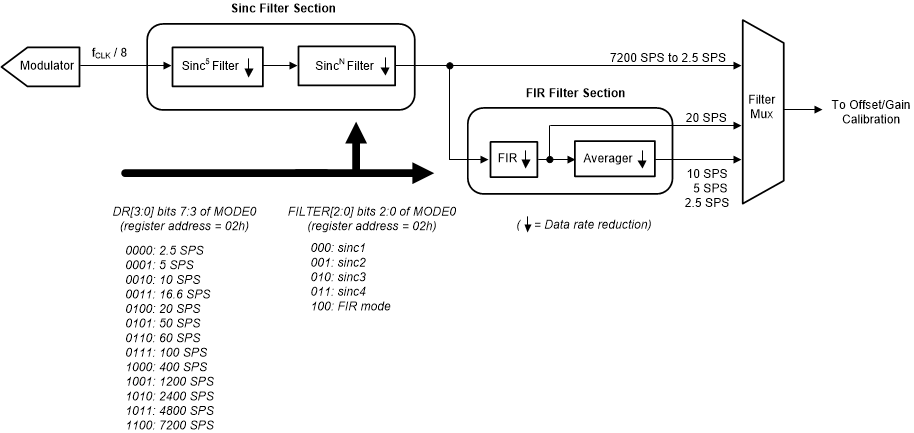ZHCSIU3 September 2018 ADS1235
PRODUCTION DATA.
- 1 特性
- 2 应用
- 3 说明
- 4 修订历史记录
- 5 Pin Configuration and Functions
- 6 Specifications
- 7 Parameter Measurement Information
-
8 Detailed Description
- 8.1 Overview
- 8.2 Functional Block Diagram
- 8.3 Feature Description
- 8.4
Device Functional Modes
- 8.4.1 Conversion Control
- 8.4.2 Chop Mode
- 8.4.3 AC-Bridge Excitation Mode
- 8.4.4 ADC Clock Mode
- 8.4.5 Power-Down Mode
- 8.4.6 Reset
- 8.4.7 Calibration
- 8.5 Programming
- 8.6
Register Map
- 8.6.1 Device Identification (ID) Register (address = 00h) [reset = Cxh]
- 8.6.2 Device Status (STATUS) Register (address = 01h) [reset = 01h]
- 8.6.3 Mode 0 (MODE0) Register (address = 02h) [reset = 24h]
- 8.6.4 Mode 1 (MODE1) Register (address = 03h) [reset = 01h]
- 8.6.5 Mode 2 (MODE2) Register (address = 04h) [reset = 00h]
- 8.6.6 Mode 3 (MODE3) Register (address = 05h) [reset = 00h]
- 8.6.7 Reference Configuration (REF) Register (address = 06h) [reset = 05h]
- 8.6.8 Offset Calibration (OFCALx) Registers (address = 07h, 08h, 09h) [reset = 00h, 00h, 00h]
- 8.6.9 Full-Scale Calibration (FSCALx) Registers (address = 0Ah, 0Bh, 0Ch) [reset = 00h, 00h, 40h]
- 8.6.10 Reserved (RESERVED) Register (address = 0Dh) [reset = FFh]
- 8.6.11 Reserved (RESERVED) Register (address = 0Eh) [reset = 00h]
- 8.6.12 Reserved (RESERVED) Register (address = 0Fh) [reset = 00h]
- 8.6.13 PGA Configuration (PGA) Register (address = 10h) [reset = 00h]
- 8.6.14 Input Multiplexer (INPMUX) Register (address = 11h) [reset = FFh]
- 9 Application and Implementation
- 10Power Supply Recommendations
- 11Layout
- 12器件和文档支持
- 13机械、封装和可订购信息
8.3.7 Digital Filter
The ADC operates on the principle of oversampling. Oversampling is defined as the ratio of the sample rate of the modulator to that of the ADC output data rate. Oversampling improves ADC noise by digital bandwidth limiting (low-pass filtering) of the data.
The digital filter receives the modulator output data and produces a high-resolution conversion result. The digital filter low-pass filters and decimates the modulator data (data rate reduction), yielding the final data output. By adjusting the type of filtering, tradeoffs are made between resolution, data throughput and line-cycle rejection.
The digital filter has two selectable modes: sin (x) / x (sinc) mode and finite impulse response (FIR) mode (see Figure 48). The sinc mode provides data rates of 2.5 SPS through 7200 SPS with variable sinc orders of 1 through 4. The FIR filter provides simultaneous rejection of 50-Hz and 60-Hz frequencies with data rates of 2.5 SPS through 20 SPS while providing single-cycle settled conversions.
 Figure 48. Digital Filter Block Diagram
Figure 48. Digital Filter Block Diagram